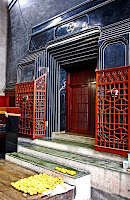At the end of Ama No To event held in Akita City on Day 3, we went to a great saké bar. As I am spending the night in the same Akita City before traveling to Yamagata, it goes without saying that I'll enjoy my drinks at Akita Nagaya Sakaba.
日本到着して3日目の夜、秋田市で行われた天の戸応援会の次に。最高な居酒屋に立ち寄った覚えがある。山形県へ向かう途中の今晩は秋田市で一泊するので、一杯する場所は言うまでも無く秋田長屋酒場。
 Namahagé mask is used for a year-end festival to ward off evil spirits.
Namahagé mask is used for a year-end festival to ward off evil spirits.
日本三大祭の一つと認められている「なまはげ」のマスク。
 I wonder what saké I should drink... let me think long and hard...
I wonder what saké I should drink... let me think long and hard...
この居酒屋ではどのお酒を注文するべきか、迷いますな~。
 As I was by myself, I sat at the counter seat. In the middle is a hibachi grill.
As I was by myself, I sat at the counter seat. In the middle is a hibachi grill.
今晩は1人なので、カウンター席で。七輪も設備されている。
 No, this is not a corn dog. It's acutally a miso-grilled Kiritanpo, a famous Akita cuisine made using Akita Komachi rice. It went very well with all three sakés I ordered (Kariho Rokushu, Ama No To Umashiné, Ama No To Junkara.) I ordered Kariho (SMV: +5, Acidity: 1.7, Rice: Miyamanishiki, Seimaibuai: 57%), as they were out of Ama No To "Kamé No O Shikomi" Junmai Ginjo. Kariho was excellent: refreshing, crisp, and clean.
No, this is not a corn dog. It's acutally a miso-grilled Kiritanpo, a famous Akita cuisine made using Akita Komachi rice. It went very well with all three sakés I ordered (Kariho Rokushu, Ama No To Umashiné, Ama No To Junkara.) I ordered Kariho (SMV: +5, Acidity: 1.7, Rice: Miyamanishiki, Seimaibuai: 57%), as they were out of Ama No To "Kamé No O Shikomi" Junmai Ginjo. Kariho was excellent: refreshing, crisp, and clean.
秋田名物のキリタンポ味噌田楽。この一品は今晩飲んだ三種類のお酒全部に合った(刈穂「六舟」吟醸、天の戸「美稲」、天の戸「純辛」。) 売り切れの天の戸「亀の尾仕込み」純米吟醸生の代わりに頼んだ刈穂「六舟」 (日本酒度 +5、酸度 1.7、原料米 美山錦、精米歩合 57%)はスッキリ感がする爽やかな辛口。
 The onsen hotel I am staying includes dinner, so I ended my visit with butter- sauteed maitaké mushrooms cooked in aluminum foil.
The onsen hotel I am staying includes dinner, so I ended my visit with butter- sauteed maitaké mushrooms cooked in aluminum foil.
泊まる温泉ホテルは夕食込みなので、ここでの注文はやや軽めで。〆は「舞茸ホイルバター焼き」。
Luckily for me, the staff remembered me from two nights ago, and were extremely friendly and kind with their services. With great food, saké selection and friendly staff, I would highly recommend this restaurant if you're in Akita.
店のスタッフさん達が私を覚えていてくれて、とても親切なサービスに恵まれました。美味い郷料理と地酒、親切なサービス、本当に最高の一晩でした。秋田市に行かれる方々には是非お勧めの居酒屋。
日本到着して3日目の夜、秋田市で行われた天の戸応援会の次に。最高な居酒屋に立ち寄った覚えがある。山形県へ向かう途中の今晩は秋田市で一泊するので、一杯する場所は言うまでも無く秋田長屋酒場。
 Namahagé mask is used for a year-end festival to ward off evil spirits.
Namahagé mask is used for a year-end festival to ward off evil spirits.日本三大祭の一つと認められている「なまはげ」のマスク。
 I wonder what saké I should drink... let me think long and hard...
I wonder what saké I should drink... let me think long and hard...この居酒屋ではどのお酒を注文するべきか、迷いますな~。
 As I was by myself, I sat at the counter seat. In the middle is a hibachi grill.
As I was by myself, I sat at the counter seat. In the middle is a hibachi grill.今晩は1人なので、カウンター席で。七輪も設備されている。
 No, this is not a corn dog. It's acutally a miso-grilled Kiritanpo, a famous Akita cuisine made using Akita Komachi rice. It went very well with all three sakés I ordered (Kariho Rokushu, Ama No To Umashiné, Ama No To Junkara.) I ordered Kariho (SMV: +5, Acidity: 1.7, Rice: Miyamanishiki, Seimaibuai: 57%), as they were out of Ama No To "Kamé No O Shikomi" Junmai Ginjo. Kariho was excellent: refreshing, crisp, and clean.
No, this is not a corn dog. It's acutally a miso-grilled Kiritanpo, a famous Akita cuisine made using Akita Komachi rice. It went very well with all three sakés I ordered (Kariho Rokushu, Ama No To Umashiné, Ama No To Junkara.) I ordered Kariho (SMV: +5, Acidity: 1.7, Rice: Miyamanishiki, Seimaibuai: 57%), as they were out of Ama No To "Kamé No O Shikomi" Junmai Ginjo. Kariho was excellent: refreshing, crisp, and clean. 秋田名物のキリタンポ味噌田楽。この一品は今晩飲んだ三種類のお酒全部に合った(刈穂「六舟」吟醸、天の戸「美稲」、天の戸「純辛」。) 売り切れの天の戸「亀の尾仕込み」純米吟醸生の代わりに頼んだ刈穂「六舟」 (日本酒度 +5、酸度 1.7、原料米 美山錦、精米歩合 57%)はスッキリ感がする爽やかな辛口。
 The onsen hotel I am staying includes dinner, so I ended my visit with butter- sauteed maitaké mushrooms cooked in aluminum foil.
The onsen hotel I am staying includes dinner, so I ended my visit with butter- sauteed maitaké mushrooms cooked in aluminum foil.泊まる温泉ホテルは夕食込みなので、ここでの注文はやや軽めで。〆は「舞茸ホイルバター焼き」。
Luckily for me, the staff remembered me from two nights ago, and were extremely friendly and kind with their services. With great food, saké selection and friendly staff, I would highly recommend this restaurant if you're in Akita.
店のスタッフさん達が私を覚えていてくれて、とても親切なサービスに恵まれました。美味い郷料理と地酒、親切なサービス、本当に最高の一晩でした。秋田市に行かれる方々には是非お勧めの居酒屋。
























































